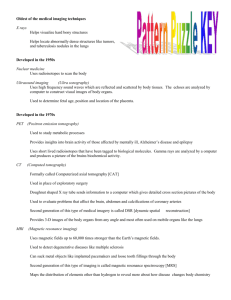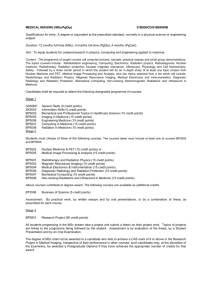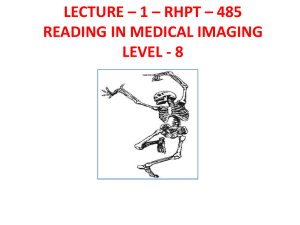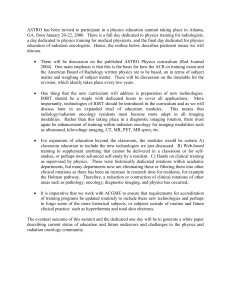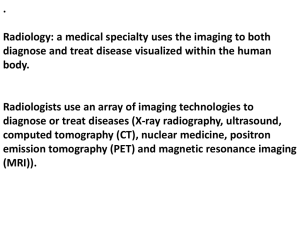X-rays
advertisement
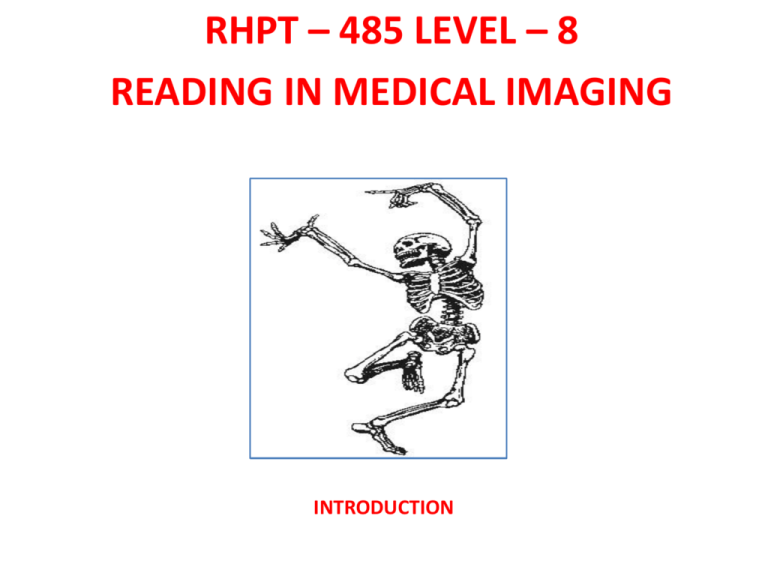
RHPT – 485 LEVEL – 8 READING IN MEDICAL IMAGING INTRODUCTION OBJECTIVES OF THE TOPIC-1 • • • • • At the end of the lecture students must be able to recognize different types of imaging modalities related to physical therapy. Students must be able to outline/mention different names of typical body regions that plain x-ray is used to evaluate. Students must be able to describe the difference between types of imaging modalities related to physical therapy based on their physical properties. Students must be able to recognize different views of the imaging film. Students must be able to outline/mention indications and contraindications of different types of imaging modalities related to physical therapy. X-RAY INTRODUCTION Discovered and named by Dr. W. C. Röentgen at University of Würzburg, 1895 Awarded first Nobel prize for physics, 1901 • In 1895 Wilhelm Conrad Roentgen discovered X-rays, so paving the way for the development of a new branch of medicine called radiology. • Initially, radiology was the science of 'X-rays', but today it involves a variety of imaging techniques to study and investigate patients so that a diagnosis can be achieved. • In addition, therapeutic procedures are performed by radiologists under image guidance, a branch also known as interventional radiology. FIRST X-RAY Roentgen’s wife's hand What are the Different Imaging Modalities Radiography “plain films” Computed axial tomography “CT” (Positron Imaging Tomography “PET”, Single Photon Emission CT “SPECT”, Combined PET-CT) Magnetic resonance imaging “MRI” Ultrasound “US” Interventional radiology “angio” RADIOLOGY TOOLS X- RAY ULTRASOUND NUCLEAR MEDICINE MAGNETIC RESONANCE COMPUTED TOMOGRAPHY 7 IONIZING RADIATION X-ray, CT, Nuclear Medicine SOUND WAVES Ultrasound MAGNETIC FIELDS / RADIO WAVES Magnetic Resonance IONIZING RADIATION X-ray, CT, Nuclear Medicine SOUND WAVES Ultrasound MAGNETIC FIELDS / RADIO WAVES Magnetic Resonance To image the patient a energy source is directed into a volume of tissue and an image is created of the tissue interaction. How to Approach Reading any Image Identify the patient When was the image taken Are these the proper images The five densities Are the images technically adequate Radiography – X - Ray Also called “plain films” or “standard films” Image formed using broad beam ionizing radiation The image formed is related to the subjects density May involve the use of contrast agents Iodinated Barium Air X-RAY High Energy Photon --Kilo Electron Volts Ionizing Radiation X-ray beam Exposes Film / Detector Projection Data detector X-rays are short-wave electromagnetic radiation produced by accelerating electrons across an evacuated tube onto a tungsten anode using a high voltage. X-RAYS PLAIN FILM RADIOGRAPHY - Clinical uses Chest Bones Spine / Extremities / Skull Soft tissue Mammography / Abdomen These are typical body regions that plain x-ray is used to evaluate. X - RAY --- FIVE BASIC DENSITIES Air / Gas Soft Tissue / Fluid filled space Bone Fat Metal • The x-rays can traverse tissue to create the image. • We can only separate the 5 basic densities noted. Air / Gas, Soft tissue / Fluid filled space, Bone, Fat & Metal. • Here we see the Air in the lungs, the soft tissue of the heart and the bone density of the ribs. • Water will appear of the same density as soft tissue and cannot be separated. Fat is difficult to see on the chest and better noted on abdominal xrays CONTRAST RADIOGRAPHY Injection, ingestion, or other placement of opaque material within the body. Improves visualization and tissue separation. Can demonstrate functional anatomy and pathology. Computed Axial Tomography Also called CAT scanning or “CT” Image formed using a rotating thin beam(s) of ionizing radiation Image “slices” reconstructed by computation The image formed is related to the subjects density Image display on computer or multiple films New technology is multislice helical scanner Uses - CT • Oncology staging • Trauma assessment • Guiding biopsies • Radiotherapy planning COMPUTED TOMOGRAPHY CT HIGH ENERGY PHOTON IONIZING RADIATION EXPOSES DETECTOR TOMOGRAPHIC DATA Here the yellow line is showing the level where the CT section is made through the upper abdomen at the level of the liver. LT Interventional Radiology Also called angiography or “angio” or “IR” Image formed using broad beam ionizing radiation (fluoroscopy) Images acquired using digital detector and processed by computer The image formed is related to the subjects density Usually involves the use of iodinated contrast agents and long catheters Many varied techniques including the use of CT or MRI Image display on computer or multiple films NUCLEAR MEDICINE High Energy Photon Ionizing Radiation --Radiopharmaceutical Exposes Detector Projection Data Dynamic / Physiologic Here we have an example of a nuclear medicine bone scan with anterior and posterior views. Ultrasound Also called “sono” or “echo” or “U/S” Image formed by transmitting and receiving high frequency sound waves Image “slices” reconstructed by computation The image formed is related to interfaces between tissue areas of differing sound transmission characteristics Image display on computer or multiple films Ultrasound does not involve ionizing radiation. It uses the principle of high-frequency sound waves, which when reflected back from structures in the body can be converted into a grey-scale image. Ultrasound is a real-time examination, which means that a moving image of the body is seen on a screen, as are the scans. Doppler ultrasound is used to measure blood flow in vascular structures and depends on the principle that there is a shift in reflected sound frequency from flowing blood in vessels. Advantages • Non-ionizing (no radiation) • Safe • Can be used to follow up patients • Images in real-time – instantaneous • Can be performed at the bedside • Relatively cheap Disadvantages • Difficult in obese patients • Views are often obscured by air/bowel gas • Poor Grey-scale image Magnetic Resonance Imaging Also called “MRI” (used to be NMRI) Image formed by transmitting and receiving radio waves inside a high magnetic field Image “slices” reconstructed by computation The image formed is related to: Scanner settings Patient hydrogen density Patient hydrogen chemical/physical environment Image display on computer or multiple films MRI is one of the newer imaging modalities that does not involve ionizing radiation. It involves the use of radio-waves and magnetic fields to create an image of the body. The patient is placed in a magnet and a radio-wave applied. The nuclei of hydrogen atoms in water and fat absorb these waves and emit radiofrequency energy and this can be manipulated by computer to produce an image. Imaging can be conducted in several planes, e.g. coronal, sagittal and axial. Imaging depends on the fact that pathological tissues return a different signal to normal tissue and this property is utilized in trying to make a diagnosis from the images. USES - MRI • • • • • • Brain, especially pituitary, posterior fossa Spinal cord Musculoskeletal Abdomen/pelvis gynecological malignancy liver Contra-indications - MRI • Pacemakers • Metallic foreign bodies etc • Claustrophobia MAGNETIC RESONANCE Hydrogen protons in a magnetic field Radio wave signal transmission No ionizing radiation Tomographic data With magnetic resonance, the tissue response to magnetic fields and radio waves serves as the basis for imaging. The images are slices or tomographic and the plane of section can be determined by the machine. Anterior MAGNETIC RESONANCE R T EXAMPLES Brain Spine Anterior Posterior Posterior Knee Anterior Posterior Angiography Angiography Real time X-ray study Catheter placed through femoral artery is directed up aorta into the cerebral vessels. Radio-opaque dye is injected and vessels are visualized Gold standard for studying cerebral vessels. Angiography AP Right ICA Lateral Right ICA AP Right Vertebral
